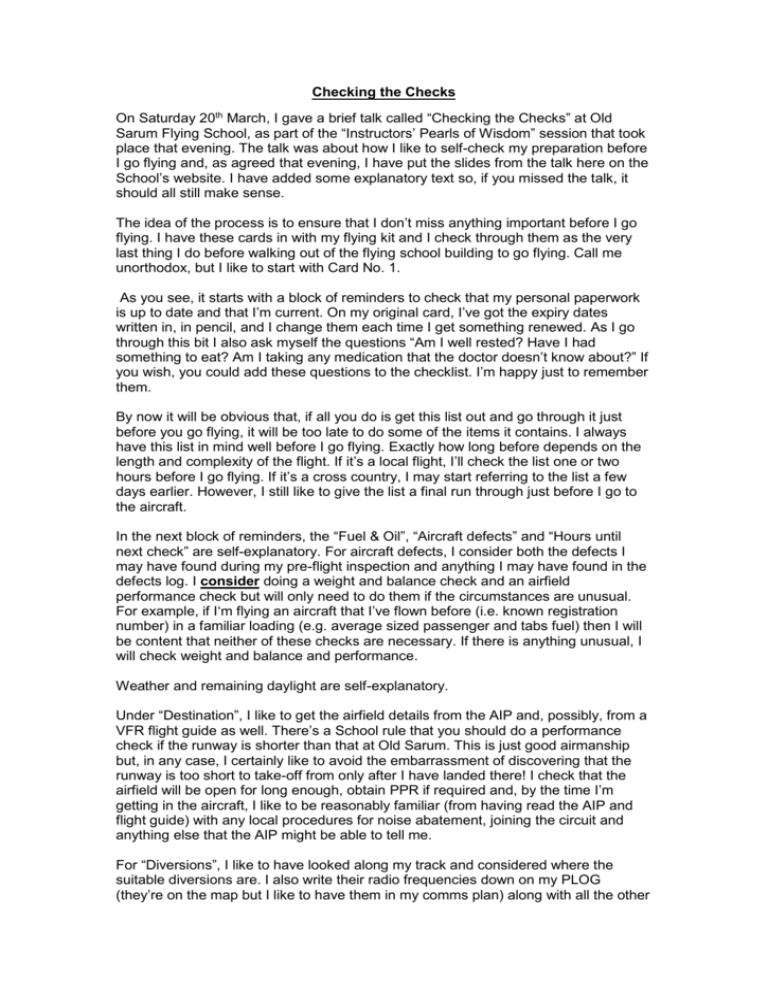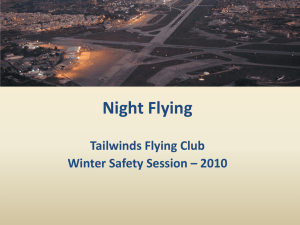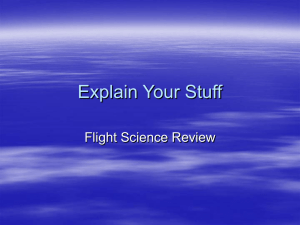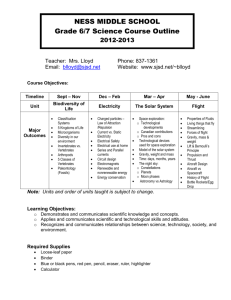Checking the Checks
advertisement

Checking the Checks On Saturday 20th March, I gave a brief talk called “Checking the Checks” at Old Sarum Flying School, as part of the “Instructors’ Pearls of Wisdom” session that took place that evening. The talk was about how I like to self-check my preparation before I go flying and, as agreed that evening, I have put the slides from the talk here on the School’s website. I have added some explanatory text so, if you missed the talk, it should all still make sense. The idea of the process is to ensure that I don’t miss anything important before I go flying. I have these cards in with my flying kit and I check through them as the very last thing I do before walking out of the flying school building to go flying. Call me unorthodox, but I like to start with Card No. 1. As you see, it starts with a block of reminders to check that my personal paperwork is up to date and that I’m current. On my original card, I’ve got the expiry dates written in, in pencil, and I change them each time I get something renewed. As I go through this bit I also ask myself the questions “Am I well rested? Have I had something to eat? Am I taking any medication that the doctor doesn’t know about?” If you wish, you could add these questions to the checklist. I’m happy just to remember them. By now it will be obvious that, if all you do is get this list out and go through it just before you go flying, it will be too late to do some of the items it contains. I always have this list in mind well before I go flying. Exactly how long before depends on the length and complexity of the flight. If it’s a local flight, I’ll check the list one or two hours before I go flying. If it’s a cross country, I may start referring to the list a few days earlier. However, I still like to give the list a final run through just before I go to the aircraft. In the next block of reminders, the “Fuel & Oil”, “Aircraft defects” and “Hours until next check” are self-explanatory. For aircraft defects, I consider both the defects I may have found during my pre-flight inspection and anything I may have found in the defects log. I consider doing a weight and balance check and an airfield performance check but will only need to do them if the circumstances are unusual. For example, if I‘m flying an aircraft that I’ve flown before (i.e. known registration number) in a familiar loading (e.g. average sized passenger and tabs fuel) then I will be content that neither of these checks are necessary. If there is anything unusual, I will check weight and balance and performance. Weather and remaining daylight are self-explanatory. Under “Destination”, I like to get the airfield details from the AIP and, possibly, from a VFR flight guide as well. There’s a School rule that you should do a performance check if the runway is shorter than that at Old Sarum. This is just good airmanship but, in any case, I certainly like to avoid the embarrassment of discovering that the runway is too short to take-off from only after I have landed there! I check that the airfield will be open for long enough, obtain PPR if required and, by the time I’m getting in the aircraft, I like to be reasonably familiar (from having read the AIP and flight guide) with any local procedures for noise abatement, joining the circuit and anything else that the AIP might be able to tell me. For “Diversions”, I like to have looked along my track and considered where the suitable diversions are. I also write their radio frequencies down on my PLOG (they’re on the map but I like to have them in my comms plan) along with all the other frequencies that I have written down, in the order that I’m expecting to need them. I confirm (to myself) that I’ve checked the Notams. If appropriate, I mark my map with any hazards and I remind myself of what was said on the AIS Information Line (Rats, Reds and Royals) when I telephoned (I’ll have scribbled it down on a spare sheet of paper on my flight board). Then I have a look at the latest Red Arrows AIC which I’ve already got printed off and added to my flying kit (in case of confliction, the AIS info is more up-to-date and therefore over-rides the AIC). Now I’m on to “Special Requirements”, which is Card No. 2. “Special Requirements”, will mean different things to different people; I will explain what it means to me. Most of my flying consists of local flights or flights to airfields within 100 nm of Old Sarum (and, usually, much closer than that). If I’m doing anything more adventurous it might need a bit more planning, so I look through Card No.2. You will have your own idea of what constitutes a “normal” flight and it is very likely to be different from mine. So, assuming you like this idea in the first place, your Card No.2 could look very different from mine and so will be the flights on which you use it. Anyway, having decided that the flight I am planning has “Special Requirements”, I look through Card No.2 and decide what, if anything, I need to do prior to the flight or take with me in the aircraft. I don’t simply take/do everything that’s on the list, I just use the Card as an aide memoire. The Card has evolved with time, mostly due to my forgetting things that I would rather have remembered! Now I’m back to the “Flight Planning” Card which, as you see, immediately refers me to my third and last card, Card No.3, “Today’s Emergency”. Speaking for myself, I find it very difficult to consider emergencies and to learn any of the procedures given in the Pilots’ Operating Handbook (POH), even though I know it’s good airmanship to do this. Using “Today’s Emergency” means I rehearse an emergency every time I go flying. I prepared the Card by considering all of the “normal” emergencies (e.g. brakes failure, engine failure in flight, radio failure) normally listed and described in the standard flying training textbooks. I then went through the POH (in this case, I used the one for the AT3) and added everything to the list that I hadn’t already got from the standard texts. I then prefixed each emergency item with a number, representing a day of the month. I’ve got 22 emergencies so now I’ve got an emergency for each day of the month up to the 22nd. I don’t want a situation where, if I go flying on any day between the 23rd and the 31st, inclusive, I don’t have an emergency to practise, so I took these remaining days of the month and distributed them amongst the existing emergencies, choosing those emergencies that I thought were the most useful to rehearse. Finally, I added the superscript numbers to refer myself to the note at the bottom of the Card which tells me whether the drill is included in the aircraft checklist or in the POH, so that I can refer to these documents to make sure I’m getting the drill right. As an example of how I use this Card, imagine that I’m sitting at home on Thursday night, thinking about a flight that I’m planning to do on the following Saturday. Next Saturday is the 27th so I look down my list for 27 which is a radio failure. My flight on the 27th is going to be to Goodwood, and I’m planning to overfly Southampton, asking Solent Radar for a VFR clearance through the Southampton Control Zone (CTR). I sit and imagine that, at some stage during the flight, I experience a radio failure of some kind. Firstly, what kind of failure is it? Is it just the transmitter or just the receiver or is it both? If it’s just a transmitter failure, does the controller realise and give me instructions or not? Does the failure occur before making contact with Solent Radar, after making contact with them but before entering the CTR, after entering the CTR but before overflying the airport or, did the failure happen after overflying Southampton but whilst still in the CTR? It’s quite a complex matrix of possibilities and I’ve got a rough idea of what I’d probably do for a radio failure at each of these stages of the flight. However, the advantage of the “Today’s Failure” idea is that it forces me (if I’m doing it properly) to consider the situation carefully and swap my rough ideas for a certain plan, checking standard text books, CAP 413 and the AIP (both the en-route and the aerodrome specific (in this case, Goodwood) sections) to remove any doubts that I might have. You’re right: the failure probably won’t happen but, now I’ve checked, and will be subjecting myself to further, random checks in the future, I’m much better placed to deal with the problem should it happen for real. Back to Card No. 1 which reminds me about passengers. I make sure that they’ve completed their membership forms and that they’ve got a headset each. Apart from pointing out the hazards of propellers and taxiing aircraft, which I do whilst still in the flying school , I prefer to brief passengers in the aircraft during the period of calm between strapping in (which is always a major faff) and starting the engine. If you’re interested, I’ve written my passenger brief at the end of this text, just before the cards. However, I vary it, depending on how much flying my passengers have done. Finally, if I’m at an airfield where booking out is not accepted over the radio, I make sure I’ve remembered to do it by telephone or whatever method is in use at that airfield. And that’s it. I’m ready to go just so long as I don’t forget the keys! I’ve included the cards on the remaining pages so feel free to amend them if you wish and print them out. Safe, happy flying, David My passenger brief: Seat belts (especially ensuring that everyone knows how to undo them). Doors (ditto). Location of fire extinguisher and first-aid kit. In the event of in-flight emergency: Tighten seat belts (if requested). Unlatch door (ditto). Brace position (ditto) (give a demo). Keep hands and feet clear of controls. Explanation of air vents (especially if Warrior). Make sure everyone’s happy with their headset. Card 1 - Flight Planning Licence valid Class rating valid Medical in date Flown within last two months (School rule) Three take-offs and landings within last 90 days if carrying passengers Fuel & Oil Weight & balance Aircraft defects Hours until next check Airfield performance Weather: Departure airfield En-route Destination Return Remaining daylight Destination Runway length Operating hours PPR Local procedures Diversions Radio Frequencies Notams 0500 354 802 Red Arrows Special Requirements Today’s Emergency Passengers Membership forms Headsets Brief Book out Card 2 - Special Requirements For a long flight, a flight abroad or a flight over water or a sparsely populated area, consider taking the following: Mobile phone OSFS: Work: 01722 322 525 Flight plan filed Passport Foreign currency Life jackets (to be worn) Life raft Dinghy captain appointed and briefed Diversion kit Wash kit Credit card Cash Aircraft documents Procedures for interception by military aircraft Warm clothing Personal locator beacon Review procedure for radio failure in controlled airspace Card 3 - Today’s Emergency 1 2/23 3/24 4 5 6/25 7 8/26 9/27 10/28 11/29 12 13 14 15 16 17/30 18/31 19 20 21 22 Engine failure before take-off.1 & 2 Engine failure after take-off.1 & 2 Engine failure during flight.1 & 2 Rough running.1 Engine fire during start.1 Engine fire during flight.1 & 2 Engine fire on ground.2 Generator/alternator failure.1 Radio failure.1 Electrical failure.2 Cabin fire. Brake failure CHT too high.2 Low fuel pressure.2 Excessive engine vibration.2 Engine over-speeding.2 Oil temperature too high.2 Oil pressure too low.2 Recovery from unintentional spin.2 Icing.2 Failure of pitot-static system.2 Failure of balance tab control system.2 Notes. 1 Drill given in OSFS checklist 2 Drill given in POH.






